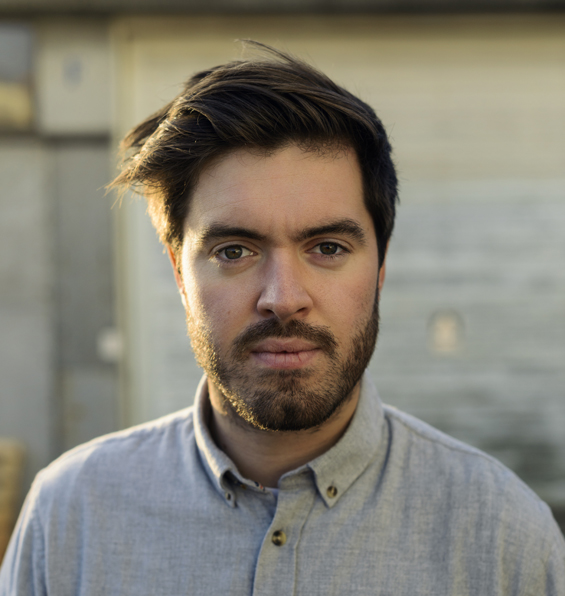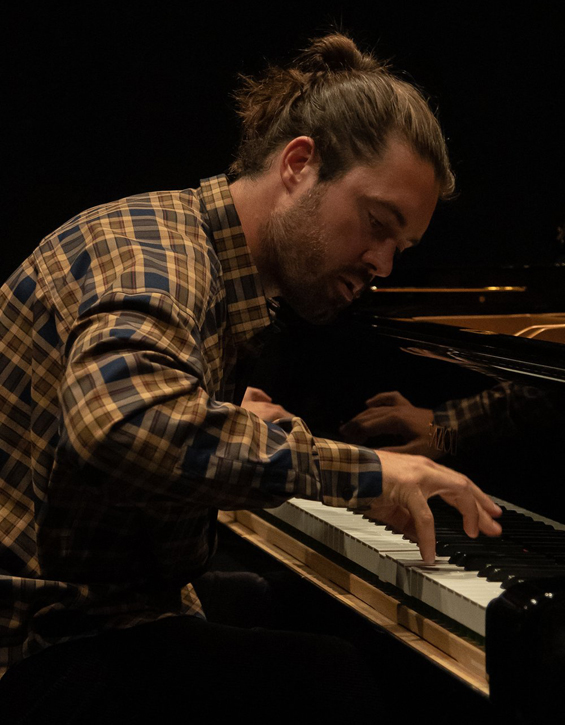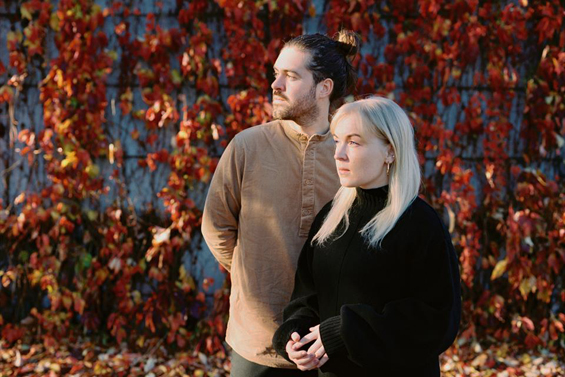

photo: Anne Valeur
FIVE QUESTIONS WITH KJETIL MULELID
Kjetil Mulelid's name has appeared many times in textura's pages, specifically in the coverage given to releases by the Norwegian jazz quartet Wako and ones by the pianist's trio and his 2021 solo release Piano. Only now, however, has an interview with him been conducted, one tailored to coincide with the release of his new album with vocalist Siril Malmedal Hauge, Blues and Bells (reviewed here). For that reason, the focus of what follows is on the duo recording, which features a terrific mix of enduring standards and contemporary pop classics—an album where swoon-inducing readings of “Emily” and “Blame It On My Youth” sit comfortably alongside inspired re-imaginings of Nick Drake's “Northern Sky” and, most audaciously, the Cocteau Twins' “Cherry-colored Funk.” The coupling of Hauge's instantly appealing voice with his highly developed piano artistry makes for music that's never less than completely engaging. Mulelid recently shed light on the project with respect to how it originated, the approach the two adopted for their interpretations, and other matters. textura is grateful to the pianist for making time to speak with us about the release in such depth.
photo: Eirik Havnes
1. How exactly did this duo project come together with Siril? Have you known one another for years and worked together for a long time? And how did the idea for creating Blues and Bells come about?
Siril and I met when we were both studying music in Trondheim around 2013 and have been playing together for almost ten years on different occasions. Back then we had a project together in the 2014-17 period with the name Fieldfare and released a self-titled EP in 2017. This was more like a pop project that we ironically started when we were both studying jazz. It was a time where I was really inspired by Glasper and his first Black Radio album, as well as artists such as Kendrick Lamar and D'Angelo. Parallel with this project Siril also made her own solo project that has kept going since, with me on piano and also Wako's Myhre Olsen on saxophone. With her solo band we've been playing most of Norway's nooks and crannies and releasing two albums (both on Jazzland Recordings), the latest one Slowly, Slowly receiving a nomination for the Norwegian Grammy Award, Spellemann.
So as you hear, we've been working for some years but never as an official duo. Then a little less than a year ago, I was asked by a Japanese record label to make a duo album. It didn't take long before I started thinking about doing it with Siril, since we'd talked about it a couple of times and also since we know each other well. We soon found out that we wanted the album to be a combination of jazz standards, some pop songs and some of our own. There was a selection period where we discussed and tried different ideas during summer 2022, and after a while we had what we thought could be it. The album was originally only going to be released in Japan, but we were very satisfied with the music and, thinking it was a shame it wouldn't be released elsewhere as well, we started contacting other labels for a collaboration. Luckily for us the Norwegian record label Grappa was very positive, and it all went very fast from idea to action. It was recorded, mixed, and mastered during September 2022, and here we are only months later talking about it.
2. Could you say a few words about the eight cover selections and how you settled on them? While the album is largely cover treatments, three songs are originals, one by Siril alone and two credited to both of you. What's the writing process like when it involves the two of you?
It took us around four months from the time we started talking about doing a duo album to when we had our arrangements of the selected songs and were ready to record. There are so many great songs that we thought of but in the end these were the ones left standing. There are three pop songs and five jazz standards, and all of them are big favourites of ours; we treated them with respect but also tried to make our own versions. “Body and Soul” was the very first jazz standard I learned, and this version has a bit of a funky vibe in the arrangement—so much fun playing this song. “Emily” was a song Siril first heard at a dinner party with some friends a couple of years ago; they all stopped talking, just sat staring at each other with tears in their eyes as they listened to this beautiful song. "For All We Know" I first discovered on the eminent album Jasmin by Jarrett and Haden, one of my favourites. As for Siril, this song was actually one that her grandma showed her when she was a little kid. She loved jazz music and wanted to introduce it to her grand-daughter; it was therefore a nice song to include for the memory of her and her passion for jazz music. As for “Blame It On My Youth,” it has an arrangement I made some years ago when I wanted to make a jazz standards album with new arrangements; the album never happened, but I remembered the arrangement of the song and decided to include it in this duo project.
“Never Let Me Go” is perhaps my absolutely favourite jazz ballad—so many fine chords and such a great melody. When a singer I used to play with when I was living in Copenhagen showed me the song, it got stuck in my mind for the rest of the year. We actually recorded it in one long sequence with Siril's song “When Wind Fades.” We both love live music and so played these two songs together with an improvised part in between. She finished “When Wind Fades” right before we started recording. She wrote it after she saw a movie about an old couple, where the woman got dementia and the relationship slowly started to fade away.
"Kanskje I Morgen'" is one of my very first songs and was written when I was around eighteen. Siril thought it would be nice to have a small little Norwegian poem added, and I couldn't agree more. My song “For You I'll Do Anything” has meant a lot to me the last few years. I wrote it for my dear girlfriend some years ago, and then included it on both my 2021 solo album Piano and also the next trio record, Who Do You Love The Most?, released a year later. Siril found the melody tempting and started writing lyrics for it. A friend of ours had a younger singer who used to be active, but she now struggles with a disease that makes her lie in bed with the curtains closed all day. The text therefore tries to describe how others now have to be someone's ears and eyes.

3. Some of the songs are strongly associated with other artists, such as “I Can't Make You Love Me” (Bonnie Raitt), “Northern Sky” (Nick Drake), and “Cherry-coloured Funk” (Cocteau Twins). Was it more difficult for you to create your own treatments when earlier versions were, I'm presuming, familiar to both of you?
Personally, Nick Drake is my absolutely favourite artist and songwriter, and I've been listening to his music for most of my life. When we agreed on doing some cover songs which were not just jazz standards it was naturally that one of his songs should be represented. I made arrangements for both "Northern Sky'' and "Which Will,” and both came together pretty naturally. We recorded both; however, only one of them that made it onto the record.
"Cherry-coloured Funk'' comes from Heaven or Las Vegas, one of Siril's favourites. The song came to her when we talked about including a song that would be a little surprising and not too obvious for a piano vocal duo. I heard Jason Moran doing a solo piano concert in August last year at Oslo Jazz festival wherein a long sequence he started playing in the lower register but eventually ended up playing a beautiful melody in the end. The contrast was amazing, and I loved it so much that I've been doing it myself at many concerts since. I thought it could fit our album as well, and this song was the one that felt most right. So the idea with the piano arrangement being dark and muttering came from there—the thought of bringing something else into the album, a fresh and almost shocking bang out of the many beautiful songs. I hope the huge contrast to the other songs make them even more beautiful. Live, we've done this song even more crazily and muddy and has been a lot of fun.
Out of the many songs we had talked about in the planning stage, “I Can't Make You Love Me” was the only one that both Siril and I thought about immediately—it must have been a common passion for the '90s since we both were born then. The arrangement I did right after we were asked to do the album—I think it was the first thing I did. I was just playing along with the Raitt version doing some rhythmic things and playing triplets. After a while I fell in love with the triplet idea and the hook that's in the instrumental part, and I just sat for some hours, singing along to the song, while playing in that same kind of vibe—and there it was, with some small harmonic changes.

photo: Svein Nesbakk
4. Did you listen to other singer-and-piano albums before recording yours, just to see how others approached it? I'm thinking that the one Bill Evans and Tony Bennett recorded in 1975 might be one that could be considered a template of sorts for a project like yours.
We've both been listening to duos for many years, and actually we both had our own active duos earlier with other partners. Evans and his work with Bennett and Monica Zetterlund have been important for us, but there're loads of others. Personally I grew up listening a lot to two albums by the duo Air & Angels that consists of singer Siri Gjære and pianist Tord Gustavsen.
5. You play in the jazz quartet Wako, have your own trio, and in addition to releasing recordings with those outfits issued a solo piano album a short while ago. Do you make adjustments to your playing style when you're performing in these different contexts, and specifically what adjustments, if any, did you make for Blues and Bells?
Yes, lots of adjustments are needed for playing with the different projects. Piano is a very all-over-the-place-instrument, almost like you're the whole orchestra. You can do the melodies, the bass, the harmonies, the rhythms, etc., and you have to decide on your part for every song and depending on who you're playing with and so on. Playing solo, you are of course very much open to do whatever you want, and you can vary between the different orchestral parameters while playing in a very floating way—some of the things I like best about playing solo. Duo playing is almost the same; however, there's someone else in your musical sphere that you have to think about and adjust to. With Siril it's often the way she is doing the melody, and if I want to join her for the melody I have to be very careful so my colour helps her instead of ruining her thoughts about what the melody flow should be like. And so it goes: in my trio it's often melody and harmony that are my responsibility, and the rhythm aspect is often something for the others to deal with. Playing in Wako or other large ensembles, I often like to think of the piano as an effect—it is often more inspiring for me to approach it that way than to think of myself as a traditional harmony player.

photo: Eirik Havnes
Bonus question: The album is entirely performed by the two of you with two exceptions: Hildegunn Øiseth plays goat horn on “I Can't Make You Love Me” and Henriette Eilertsen flute on “Northern Sky.” What prompted the two of you to deviate from the vocals-and-piano template and add instruments to those songs?
The idea of bringing a couple of guest musicians came from making the arrangement for "Northern Sky." I heard a song by Samora Pinderhughes where his sister Elena plays a flute solo and thought the combination of piano, flute, and voice sounded amazing and so wanted to try it in this project. Henriette absolutely kills it on "Northern Sky,” and I'm so happy she joined us in the studio. When I was doing the arrangement for “I Can't Make You Love Me,” I heard some more airy sound and first thought about a soft trumpet. Then I started thinking having heard Hildegunn playing goat horn a couple of months earlier, and the idea was born. The goat horn is an absolutely unbelievable instrument, and Hildegunn sounds stunningly beautiful on the recording. Her contribution on the outro to “Body and Soul” was a lucky coincidence. She arrived early to the studio as we were almost finished recording the song and jumped in to play along with us. It ended up pretty cool, we think.
website: KJETIL MULELIDApril 2023![]()